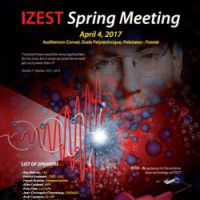-
LWA and PWA: how far are we from reality
This Spring meeting will focus on the different techniques leading to efficient and affordable particle acceleration schemes in the TeV regime. Today’s and future’s high energy physics rely on extremely large radiofrequency accelerators with tens of kilometres in length. These systems have reached the limit of affordability from a cost, size and maintenance point of view. For more than 20 years numerous groups have tried to study and improve the concept introduced by Tajima et Dawson [1] known as Laser Wake Field Acceleration.(LWA). The latter, was extended few year after by P. Chen et al [2] to particle, electron and proton, called Plasma Wakefield acceleration (PWA). Gradients as high as GeV/cm have been demonstrated, representing a gain 1000 times over RF technology. The AWAKE project using protons is studied by CERN while SLAC (FACET) has demonstrated the effect with electrons.
To become reality, the major hurdles facing LWA, is the lack of high average power and high efficiency driver. In order to surmount these difficulties, we will discuss the progresses made in this area, particularly with the novel fiber-based infrastructure, XCAN [4]. We will also compare the cost of the two technologies, laser and radiofrequency. -
High Energy Pulse compression in the single cycle regime [4]
The generation of ultra-high energy particles in the GeV regime strongly depends on high peak power and short pulse duration. One technique has been recently proposed and actively investigated is the thin film compression concept [4]. Used in conjunction with a PW laser, this technique could produce single cycle pulse with energy in the tens of joules. Simulation shows that relativistic GeV protons can be produced by interacting the single cycle pulse with a thin target [5]. -
Fundamental Physics: Black Hole information paradox and Dark matter’s search.
A newly proposed experiment promises to create a “tabletop” black hole [5] that could prove whether information is truly lost when black holes evaporate. The idea that information could be lost this way has created a paradox in our current understanding of basic physics. -
Societal Applications.
Novel laser architecture and pulse compression technique opens the door to new societal applications in the medical, environment and space field.
• Proton therapy,
• Transmutation of nuclear waste.
• Space debris mitigation [7]
References
1. T Tajima, JM Dawson Physical Review Letters 43 (4), 267
2. P. Chen, J. M. Dawson, R. W. Huff and T. Katsouleas, Phys. Rev. Lett. 54 (1985) 693
3. Gerard Mourou, Bill Brocklesby, Toshiki Tajima, and Jens Limpert, The future is Fiber Accelerators, Nature Photonics, Vol.7, 258-261 (2013)
4. G. Mourou, S. Mironov, E. Khazanov and A. Sergeev, Single cycle thin film compressor; opening the. Zeptosecond-Exawatt Physics , Eur. Phys. J. Special Topics, 223, 1181(2014)
5. M.L. Zhou, X.Q. Yan, G. Mourou, J.A. Wheeler, J.H. Bin, J. Schreiber and T. Tajima, Phys.Plasmas 23. O431129, 2016) Proton acceleration by single cycle laser pulses offers a novel mono energetic and stable operating regime
6. P. Chen and G. Mourou Physical Review Letters on January 23 , Phys. Rev. Lett. 118, 045001 (2017)
7. T.Ebisuzaki, M. Quinn , G. Mourou, Acta Astronautica 112. 2015 Demonstration designs for the remediation of space debris from the International Space Station
